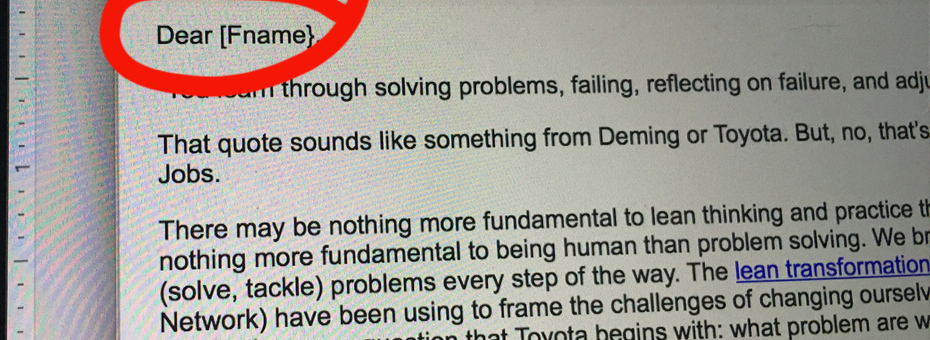What better way to introduce a book about problem solving?
I just sent 80,000 emails to [F-Name]. You may have received one. That’s right, I created a perfect case study for us to learn from. It’s exactly as I planned….. But in reality I made a mistake. An extremely public one.
So all our lovely community members got an email last week that said “Dear [F-Name].”
Yup, you read that right.
After the shock and horror of it all, I stopped myself from spinning and sat down and thought okay what is the process and did you follow it?
Although at first I was ashamed and embarrassed, I was reminded of an article from our LGN friend, Boaz Tamir, who said “From our point of view, mistakes are a natural, daily situation, so we try to help people let go of shame when they make a mistake.” To let go of the shame, I decided to really own my mistake, so I emailed all LEI staff members, described my problem, and asked for help and I started with the process.
For starters, I went to “gemba,” which in this case is the sequence of actions we took to complete and distribute this mass email. Here are the current standard process steps:
- Receive final email text
- Place final email text in email program with all correct links
- Send email to proofer (varies depending on email)
- Get edits from proofer
- Make edits
- If minor changes (typos) no further proofing needed
- If major changes (rewritten or links) proof again
- Schedule email
Where did I go wrong?
First of all, I should mention that this same type of error has happened four years before. My colleague Josh Rapoza shared his experience with us here. Having passed on this job and with new people involved in the process, I wonder if we all understand the current standard process steps and our roles in it clearly. Looks like it’s time to PDCA again.
Here’s what went down before I hit send.
Before this letter was finalized and handed to me for email distribution it went through multiple rounds of edits with the writer, editor and a few others. I was also involved in the initial review process as graphics were needed for this piece, which is not always the case. I typically only get involved when the letter has been finalized.
On first test proof from the email distribution program the writer decided to make additional edits, removing a couple of paragraphs, and the proofer gave a few small typos to correct. Given the edits I decided that another proofer was not needed so I proofed the changes I made and prepared the letter for distribution.
Looking back on the edits that were requested, removing several paragraphs, perhaps I should have had another person proof it again? But when I went back to the first proof as I started to investigate why this happened, the error was there and had been missed. Would an additional set of eyes have caught the error that wasn’t seen during the first proof?
I continued to reflect and it occured to me that the proofer for test 1 was traveling and had already been part of the round of edits making the proofer not be the fresh set of eyes needed. Was he the right person to proof?
Lucky for me, I work with incredible people at a company that teaches this very thing – problem solving. Right now this is a Type One problem – troubleshooting as stated in our Four Types of Problems book. If a trend or pattern emerges, it could become a Type Two. But for now, a little troubleshooting is called for.
How do I deal with this NOW?
- Send out another correct email?
- Send out an apology?
- Ignore it and pray the day ends soon
The above questions brought me back to the process steps I outlined above. I did not have any steps on how to deal with this as a problem even though we had encountered them before. Possible countermeasure here? After a bit of discussion we decided to let it stand and not flood our communities email boxes with another email.
The problem solving doesn’t stop here, sure we solved the Type One problem. BUT we still need to figure out what went wrong to stop it from happening again. We had a gap from standard, a Type Two problem that requires more investigation and more “whys.”
To begin to tackle the this Type Two problem the team involved will map out the process together and analyze all the steps and be coached by our colleagues and LEI lean coaches, Josh Howell and Mark Reich. We will share our findings next month so you all can learn with us, after all there’s always room for improvement and every second matters as my friend Tracey Richardson shares.






